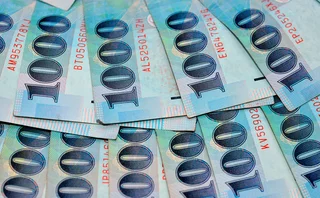
Dollar/yen break-out expected
Technical indicators suggest the dollar/yen exchange rate could be set to break out of the tight trading range it has been trapped in since June, says RiskNews’ sister publication, FX Week .
Analysts are largely split into two camps. Some expect the yen to strengthen to breach its lower limit of 103 per dollar, believing the worst of the Japanese economic data currently affecting the currency to be priced in.
Others, however, believe that against the recent weak economic background, pessimism is taking a toll on the currency, and the break-out could be to the upside, breaching 112. This view is bolstered by expectations of continued interest rate hikes in the US supported by the maintenance of a strong currency policy by the government.
Either way, the impact the current trading range is having on the country's exporters is limited. Joe Kraft, head of foreign exchange at Morgan Stanley in Tokyo, notes that in general Japanese exporters' hedge ratios are relatively high and are hedged up to November "so in that regard there's no sense of panic".
Still, problems will prevail if the yen appreciates significantly and breaks 105, said Brown Brothers Harriman. Jun Kitazawa, assistant vice-president at the bank in Tokyo, said most companies have set their cost equivalent rate at 105 and a breach beyond that level would cause a rush to sell dollars.
Mike Newton, currency strategist at HSBC in Hong Kong, believes there are four factors to watch out for in terms of the yen: what will happen to the Nikkei; the outlook for Japanese government bond yields; the impact of the oil price on the Japanese current account; and the trade outlook with China.
Only users who have a paid subscription or are part of a corporate subscription are able to print or copy content.
To access these options, along with all other subscription benefits, please contact info@risk.net or view our subscription options here: http://subscriptions.risk.net/subscribe
You are currently unable to print this content. Please contact info@risk.net to find out more.
You are currently unable to copy this content. Please contact info@risk.net to find out more.
Copyright Infopro Digital Limited. All rights reserved.
As outlined in our terms and conditions, https://www.infopro-digital.com/terms-and-conditions/subscriptions/ (point 2.4), printing is limited to a single copy.
If you would like to purchase additional rights please email info@risk.net
Copyright Infopro Digital Limited. All rights reserved.
You may share this content using our article tools. As outlined in our terms and conditions, https://www.infopro-digital.com/terms-and-conditions/subscriptions/ (clause 2.4), an Authorised User may only make one copy of the materials for their own personal use. You must also comply with the restrictions in clause 2.5.
If you would like to purchase additional rights please email info@risk.net
More on Foreign exchange
Will Taiwan lifers ramp up FX hedging amid tariff turmoil?
As TWD remains strong against the US dollar, Taiwanese life insurers are still poised to act
Deutsche Bank takes AutobahnFX on the open road
Proprietary trading platform sets out new workflow-based approach to collaborating with venues
Dealers bullish on Bloomberg chat interface for FX markets
Service expanded its API offering to integrate broker chats into banks’ engines for cash FX pricing late last year
LCH expects to boost deliverable FX clearing with new adds
Onboarding of dealers and link-up with CLS could swell interbank deliverable FX clearing volumes
Does no-hedge strategy stack up for mag seven mavericks?
At Amazon, Meta and Tesla, the lack of FX hedging might raise eyebrows, but isn’t necessarily a losing technique
Amazon, Meta and Tesla reject FX hedging
Risk.net study shows tech giants don’t hedge day-to-day exposures
Intraday FX swaps could signal new dawn for liquidity management
Seedling market could help banks pre-fund payments in near-real time and reduce HQLA requirements
Natixis turns on the taps in flow trading
French bank boosts flow business, balancing structured solutions capabilities







